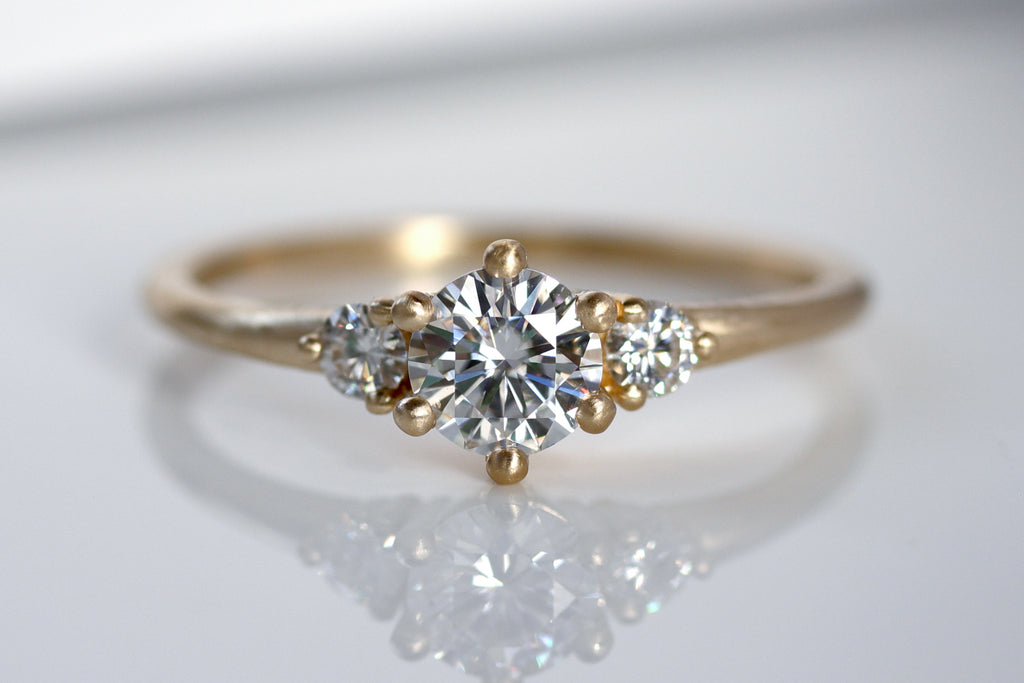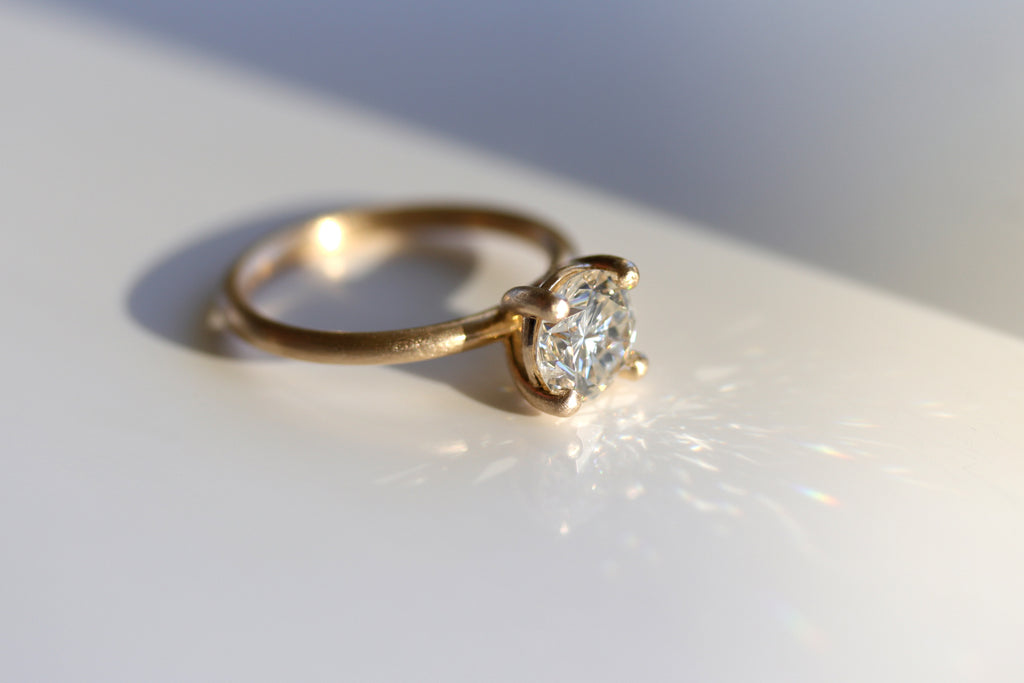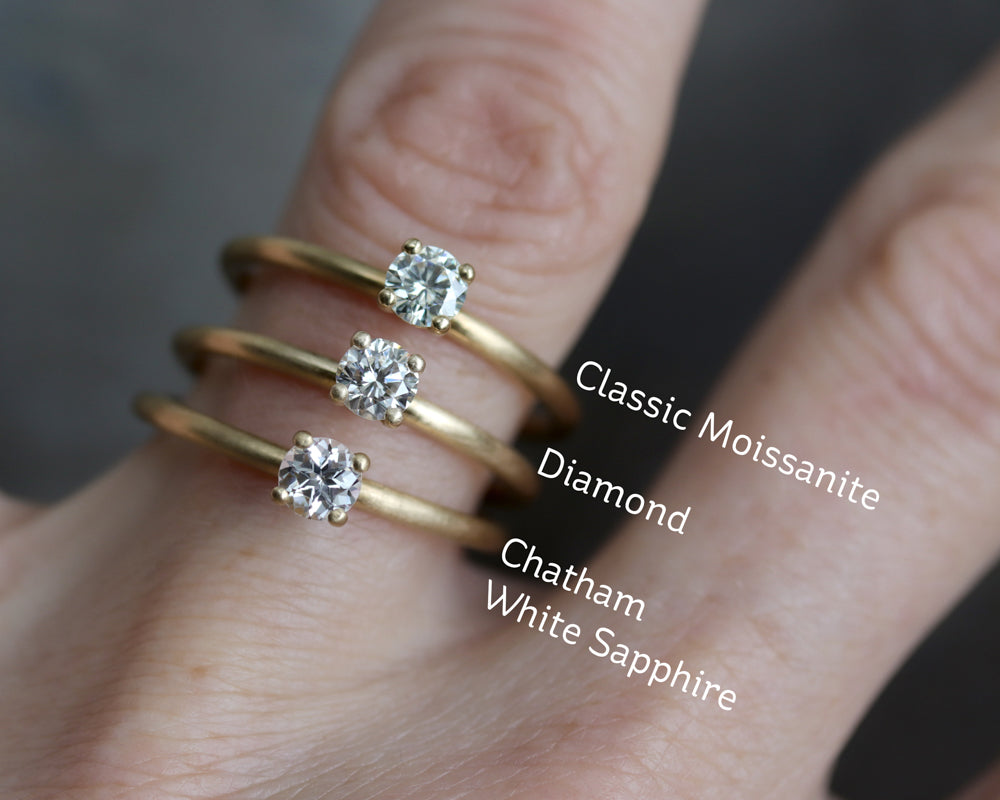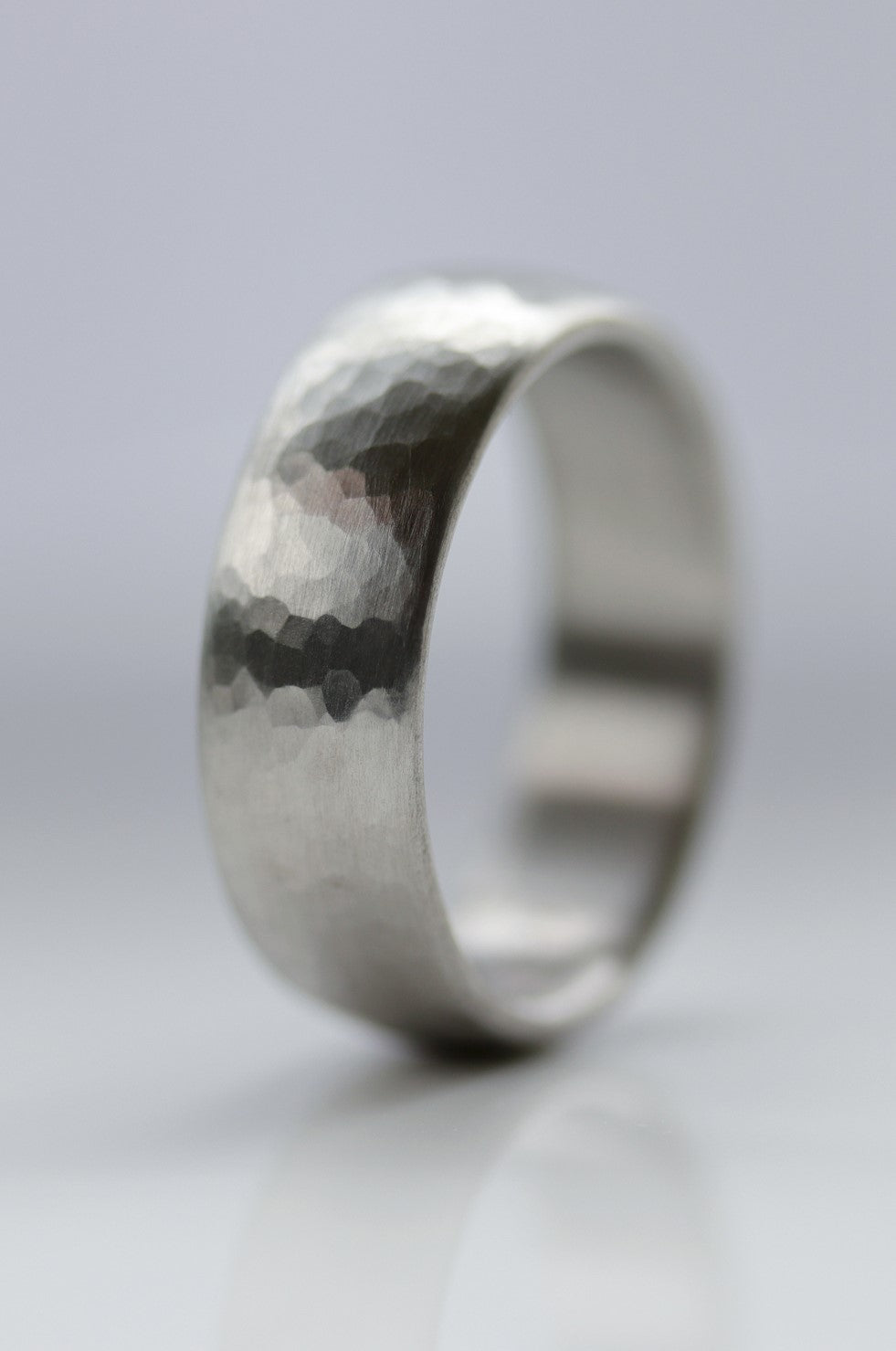Moissanite vs Diamond vs White Sapphire: What is the difference?
Note: We've published an updated guide that includes information about lab-grown diamonds vs natural diamonds vs moissanite. Read the full guide here.
White sapphire vs diamond vs moissanite – how do you choose, and what is the difference between these three popular engagement ring stones? This guide will help you sort through these options to choose the white stone that is right for your engagement ring.

White Sapphire
- Least expensive option
- 9 on the Moh's Harness Scale
- More transparent and less sparkly than diamond or moissanite
- Can have a slightly blue tint
- Available in natural and lab-grown
Moissanite
- Middle price option
- 9.25 on the Moh's Hardness Scale
- As much sparkle as a diamond
- More fire (rainbow flashes of light) than a diamond
- Available in three different color grades
- Available only in lab-grown
Diamond
- Most expensive option, but prices can range dramatically depending on quality
- 10 on the Moh's Hardness Scale - the hardest known mineral
- Diamonds can have unmatched brilliance, beauty and hardness
- Graded on the 4Cs
- Available in natural and lab-grown
This comparison video features our 4mm Basket Solitaire. Watch it in full screen to really see how light reflects differently on the different stones.
White Sapphire

There are natural and lab-grown white sapphires on the market. Lab-grown white sapphires are readily available whereas natural white sapphires are rare or are treated to remove color. We prefer the lab-grown white sapphires for their color (or lack of it), superior clarity and more affordable price. White sapphire can sometimes have a very slightly blueish tint to it. Sapphires are corundum, which means it is durable enough for everyday wear (9 on Moh’s Hardness Scale and third to a diamond) and is also resistant to chipping.
The biggest thing to consider with a white sapphire is that they are more transparent. They don’t reflect light as much as a diamond or moissanite, which makes them much less sparkly than the other two. So if you are someone who wants a more subtle and less sparkly engagement ring, white sapphire might be the stone for you.
Because they reflect less light, they are also more transparent, which allows the metal color of the setting to show through (as seen in the ring below). The biggest drawback of their transparency is that dirt and build-up will show much more on a sapphire and can cause it to look dull if not regularly cleaned. Get our tips on cleaning your jewelry in this blog post.
 Oblique Solitaire Engagement Ring with a white sapphire bezel set in 14k rose gold.
Oblique Solitaire Engagement Ring with a white sapphire bezel set in 14k rose gold.
Moissanite

Moissanite is visually going to be the closest to a diamond. Moissanite has as much sparkle as a diamond, but it also has more fire (rainbow flashes) than a diamond. If you love sparkle, moissanite is a great choice! Though it can have too much fire for some people's taste and at times creating a sort of disco ball effect. This effect is much more noticeable in larger sizes – above about 6mm or .80ct.
Moissanite is made of silicon carbide. All moissanite on the market is lab-grown since natural moissanite is incredibly rare. It is second hardest to diamonds (9.25 on Moh's Hardness Scale) and durable for everyday wear.
One other difference you'll notice with moissanite is facets can sometimes appear black/dark at certain angles to the light. This is a result of its crystal structure, which is different than a diamond.
All moissanite looks virtually the same as far as cut and clarity go, so they don't have the unique and individual characteristics that a diamond can have. They also have incredibly high clarity. You will not see inclusions in moissanite even under 10x magnification. The only one of the 4Cs that apply to moissanite is color. Traditional moissanite can have a yellowish tint because they are in the J-K color range, Forever One Near Colorless is in the G-I color range, and Forever One Colorless is in the D-F color range.
Overall though, to the average person viewing a diamond and moissanite in person, they probably wouldn't be able to tell the difference between the two. So, if you want something that looks like a diamond with high durability, but for less money, moissanite is the best choice.
Note: For small accent stones (melee), lab-grown diamonds are often less expensive than moissanite. The price advantage for moissanite is most significant in center stones 0.50ct and above.

Six Prong Low-base Three Stone Engagement Ring with forever one moissanites in 14k yellow gold.
Diamonds

Diamonds are the classic go-to for an engagement ring, and while moissanite has as much sparkle as a diamond, the sparkle isn't as clear and vibrant. Diamonds also do not appear dark at times, the way that a moissanite can. And while moissanite is second in hardness to diamonds, diamonds are much much harder than any other stone and 4x harder than a sapphire. You can also get a diamond that is more colorless than moissanite or sapphire.
Another thing to consider is the heirloom factor. Diamonds are the most popular choice for heirloom stones. Moissanite or sapphire is an excellent option for your engagement ring. But, if you want a stone that you can pass down to your children or grandchildren, a diamond is a much better option due to its intrinsic value and hardness.
Made of carbon, diamonds are the hardest gemstone, making it the most durable for everyday wear - 10 on Moh's Hardness Scale. Diamonds are graded on the 4C's - cut, clarity, color, and carat (moissanite and sapphires are not). Prices vary widely based on the 4C's, and lab-grown vs. natural. Lab-grown diamonds are chemically identical to natural diamonds. Learn more about the differences between natural and lab-grown diamonds in our detailed guide.
Learn about how we source the different diamonds here.

Basket Solitaire Engagement Ring with an heirloom diamond set in yellow gold.

While this blog post is about white stone options, we also love colored sapphires. You can see some of the pieces we’ve created with colored gemstones on our custom items page.
